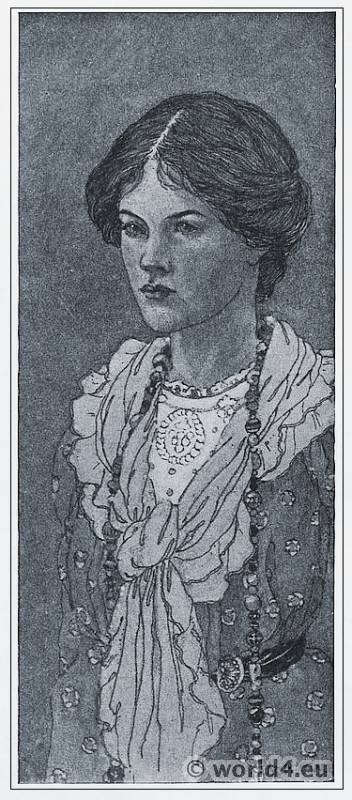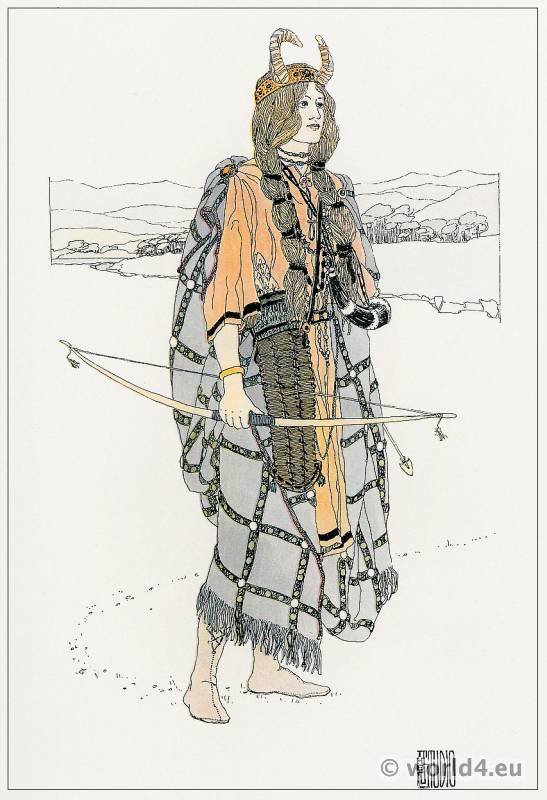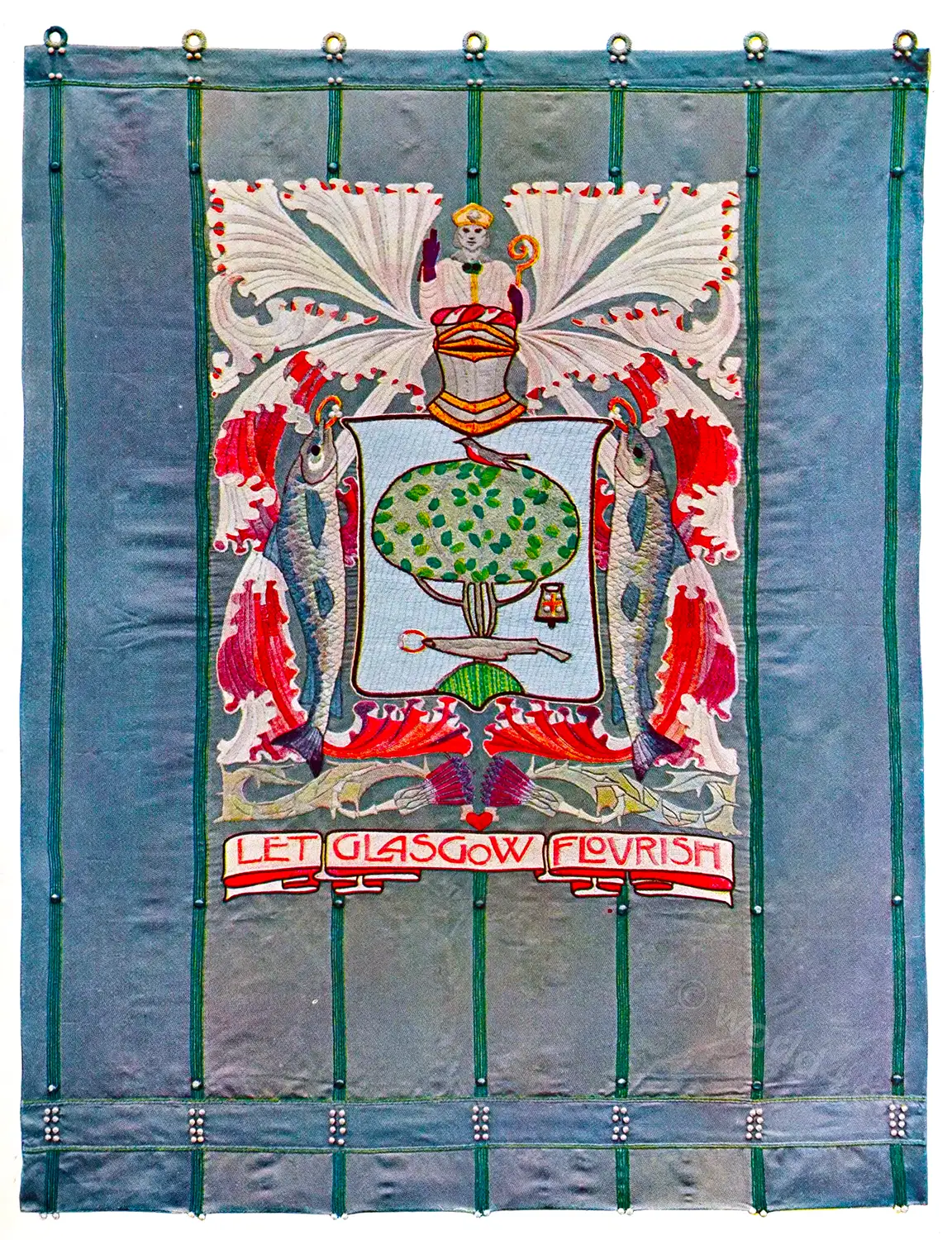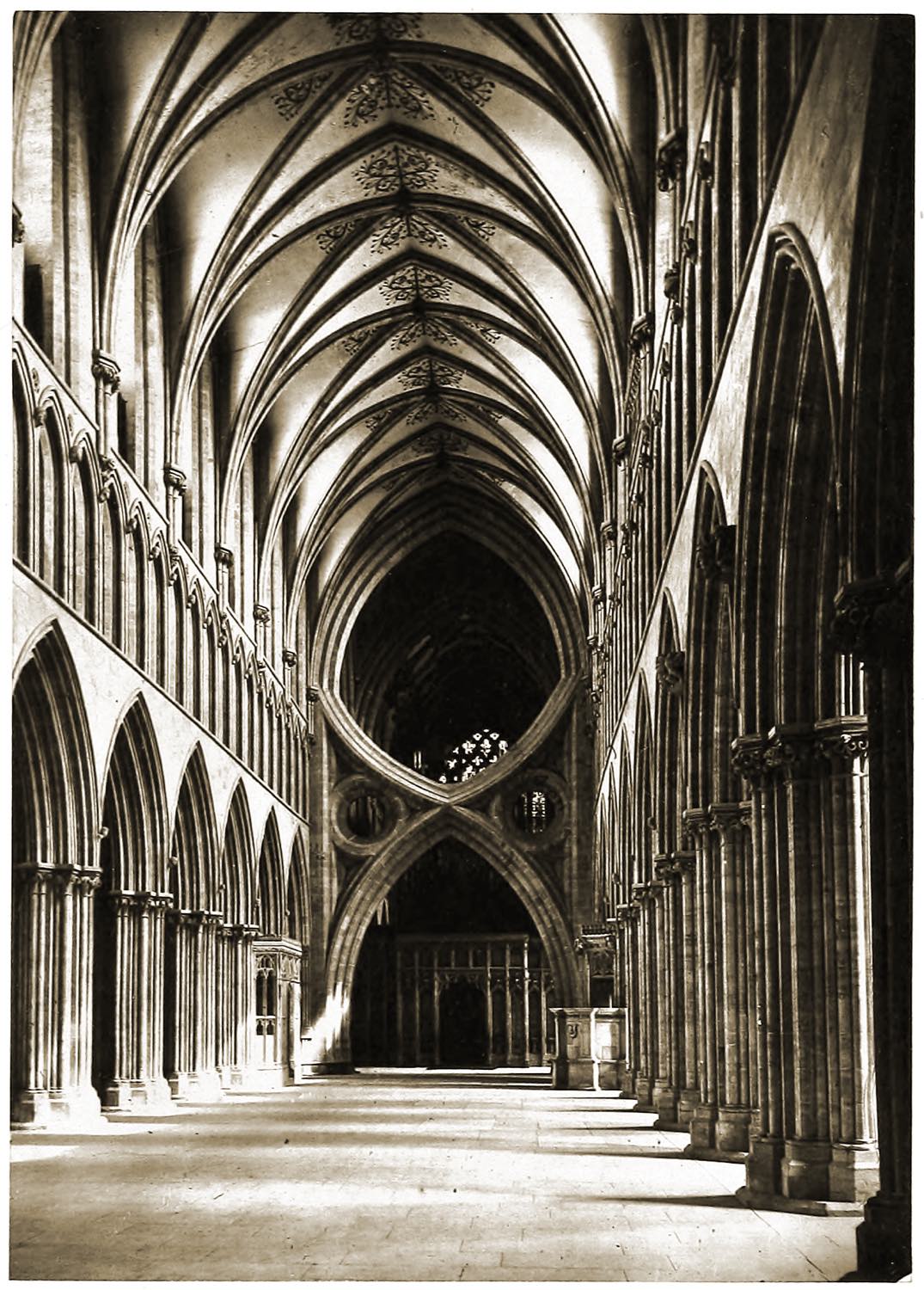An Appreciation of the work of Ann Macbeth 1875–1948.
The association of the needle is with the woman’s hand, and though the sewing machine may have robbed the expression of much of its truth and of all its sentiment, it may still be said, to paraphrase the words of a well-known dictum, that “the hand that holds the needle beautifies the world.” And by this no disparagement is intended of that vast army of tailors whose office it is to clothe mankind.
For the dress of the modern Occidental man knows no art in its composition, nor can decoration, however added, redeem it from its state of sad monotony. But happily the work of the needle is not solely confined to the manufacture, or even the decoration, of garments, and in the hand of the woman it makes its appeal in poetry and has its place in art.
As the plough to the peasant or the pen to the writer, so the needle lives in our sentiments as a personal effect of the woman—part of her physical belongings, as it were, and without which life would be incomplete, and the world a loser of a form of art which is almost coeval with the existence of mankind. And the needle bears with it a dignity of labour that, if it be not greater than the plough, is yet one that puts it into the same category of absolute necessities.
For man, if he cannot live without the plough, can equally as little do without the labour of the needle. And, to make another comparison, much of the poetry which comes from the pen is not for a moment to be compared with those harmonies of form and colour which owe their origin to the art of embroidery— the art by instinct of the woman. And this instinct, whether primitive or inherited, remains with some women as a constant quantity — an artistic expression ever seeking outlet.
And among such artists is Miss Ann Macbeth, whose works illustrate this article. With no one is the association of the needle and the hand more close or the results more precious than with her, and she may fairly be said to belong to that class of workers who claim companionship with Penelope and find themselves at home in the company of those Mediaeval artists, whether ecclesiastical or lay, whose needles have made history and whose efforts are to be met with in the sacristy of the church, among the treasures of the castle and house, or more fully given to the world as forming part of the collections of our various museums.
But we have in these latter days lost sight somewhat of that traditional use of the needle which in not very remote days brought a personal element to bear upon the beauty of household surroundings. The domestic supply that existed so fruitfully has been supplanted by the art needlework emporium.
Formerly no young girl’s education was judged to be completed until she had worked her sampler and had thus added her share to the accepted tradition of needlework, and carried it a generation farther on. For the sampler was a purely traditional piece of art needlework, whose stitches and ornament were a heritage transmitted from mother to daughter; it was rarely ugly, oftentimes was very beautiful, and bore on its face a standard of artistic value that makes it to-day one of the sought-for treasures of the antique collector. And the skill thus attained by the young worker was an abiding one, and her needle found employment in a hundred ways that to-day are either forgotten or are relegated to the shop or to the machine.
The pride of the bride used to be in her napery. Her dower chest was gifted her, that she might store those productions of the loom and needle that should beautify the bed whereon she was to sleep and the table at which she was to preside; and much of genius and a great deal of skill was brought to bear upon articles alike of use and for ornament, so that the everyday handlings of life were broidered with beauty and enhanced by art, even as the flowers of the hedgerow, the traveller’s joy, and the vagrant honeysuckle, the hop, and the bryony broider the hedges of the English highroads. And no one questions the joy that comes from an environment of household wares that, compelled by use, are enhanced by art in their making.
If the magic of beauty, the effect of temperament, can be added to the things we needs must have, must needs use, the having and using give sensations of absolute pleasure. And if this be possible, as indeed it is, then the objection that beauty is rare, and therefore dear, and, as a quality, must always remain a possession for the few, must be met and combated. Beauty is not for the few, but for the many, and that it is costly is no valid objection. It costs no more to create a beautiful object than it does to produce an ugly one, and ugliness incarnate is oftentimes dearer than beauty, although less may have been paid for the former. The price of the material in an ugly production is oftentimes more than that contained in a beautiful object.
The purchaser of a picture does not pay merely for the tubes of colours used nor for the canvas employed, nor even for the mere time of the artist; he pays for that power that transmutes both pigments and time into beauty. And nowadays there is far too much money invested in the painted side of beauty, and not nearly enough given for that art that expresses itself through the table-cloth that covers our table or the towel upon which we dry our hands. Adam Smith, in his “Wealth of Nations,” left out of account those priceless treasures which we possess in our pictures—wealth that makes poor nations rich, and without which wealthy nations are poor. How much more wealth could he have attributed to nations had he taken into consideration that inexpressible and untold value which the application of art to common things brings alike to maker and to user! And if this honour can be given to the articles that are thus treated, how much greater is the credit due to the worker who produces them!

And to Ann Macbeth every commendation can be paid for the part she is taking in this addition of beauty to our daily surroundings. With her, the art of the needle is at once the object of her life and a means for the fullest expression of a nature that teems with artistic sentiments and ideas. And she has no false pretences as to the value of the good she may possibly be doing in the world. She is content simply to be a worker, doing practical and useful work, and finding for it a place in the market and by it a subsistence for herself.
Coming of an artistic stock, and bearing a name that figures in more than one list of Royal Academicians, Ann Macbeth began life, if heredity counts for anything, with helpful instincts. But unlike so many art workers of the present day, who start designing before they draw, and claim credit for novelty of idea where workmanship would have been more desirable, Miss Macbeth kept her design aspirations in the background until she had made herself a competent draughtswoman, and had mastered the art of drawing, without which design is as lifeless as a body without a soul.
Like the old Italian masters she arrived at a knowledge of ornament through the practice of drawing from the figure: and when at length she turned her attention to traditional ornament, she found herself in a position to ignore it, and to start where the mediaeval ornamentists did—namely, at and with Nature. By her education she had placed herself in the position of being a creative artist, instead of a follower of tradition, and this gave her a distinct advantage over the old sampler worker. For unless tradition in art be added to, be made to live, and be brought up to date as a living entity, there is a fear that it must die of sheer inanition, and history repeats this lesson.
Ornament, to be worthy of the name, must be more than an aggregation of conventional forms to be used on occasion, like recipes taken from a cookery book. It must be a personal belonging, and have a distinct relation not only to the ego of the creator, but also to the period in which it was created. But this presupposes power to transform, talent to adapt, and, above all, genius to create; and herein comes the good of a sound education, such as Miss Macbeth possesses.
To be original in any sense of the word is, first, to find out what has been done, and then to learn the further possibilities both of material and of treatment. Otherwise originality becomes a travesty, and creation (so-called) merely a borrowing. But the instinct that can trace the hieroglyphical forms on a Persian carpet back to the nature from which they were adapted can start again with that nature, and end at a point beyond that, it may be, which the Persian reached. And, what is more, the worker may finish with that touch of nature which the Oriental never had, and thus make a deeper appeal to our senses, because of the added comparison we are able to make between means and ends. But with the possession of such power comes the application, and Miss Macbeth, instead of producing work which, though beautiful in itself, should, like the painted picture, be unrelated to ordinary surroundings, set herself steadfastly from the very first to execute work which should enter into daily life and have an interest because it was a part of our everyday surroundings. And in this endeavour she is much helped by her own very practical outlook on things.
Thus, how dress and personal adornment could be simplified and at the same time beautified, early made a strong appeal to her. How stuffs, plain, yet of sound quality and of good colour, could be beautified by the addition of embroidery or other aids to decoration, led her to essay the art of applique and to endeavour to mosaic upon a ground an ornamental treatment in another colour, which should enhance the dress as a possession, without adding much to the original cost. Not that there is anything new in this.
The dresses of the mediaeval Italian women, as depicted by artists like Ghirlandaio or Botticelli, glow with appliqué and embroidery; but whereas precious materials, gold, silver, and jewels, entered into their making, with Miss Macbeth the setting of one piece of coloured cloth upon another, and the putting of a border of sewn thread or silk around it, gave the added piece all the appearance and value of a precious metal or of a jewel set among its surroundings. Further, these spots of colour, thus superimposed, are connected, and the design made into a whole, by spots and lines of colour or by ornament, chiefly floral, characteristically conventionalised from Nature.
This class of work she applies with success to almost every article where its use is possible and permissible; and the plenishings of the drawing-room, the dining-room, and the bedroom have all received attention. But she has not entirely confined her energies to the decoration of articles of mere necessity. Her knowledge of the figure has enabled her to grapple with the possibilities of its use in design; and various needlework panels of figure subjects, some of which have been already illustrated in The Studio, are the fruits of her work in this direction. Notably, also, a coloured reproduction of one side of the British Association banner for the Glasgow meeting of 1901, and which appeared in The Studio for January, 1902, is a charming example of how heraldry may be utilised for the purposes, of pageantry. Another fruitful field for art work—namely, designs for sewed book-covers, for which a tradition once existed in England — owes some progress to Miss Macbeth.
And the attitude she stands in to her work is shown by her treatment of it. She does not feel that it is enough to merely design and let others execute. She believes that the artist who produces the design is generally the person best fitted to carry it out, and most pieces of work for which she is responsible owe their execution, either in part or the whole, to her own needle. And this, is the true artistic position. To completely know how to design for any material, it is necessary to be a worker in that material. For there should be no real fixity of idea in a design that is being produced by the hand. It should be possible to make any change of intention as the work proceeds, and it may be that the best design is, in the long run, the one the whose general scheme is understood from the beginning, but whose details are studied and carried out as the work proceeds. By such means artistic instinct is always kept on the alert, and the opportunity left open for the attainment of the best possible result.
And to show that this work of Ann Macbeth’s is one that by its influence is likely to improve current taste in embroidery, it should be mentioned that she is in touch with a world-known London firm, who have given a special name to her work, and are willing to take as much of it as she cares to send them. That she is kept busy in the supply is a practical testimony to the success of her efforts. As a further addition to her powers, Miss Macbeth possesses in no small degree the art of imparting instruction to others; and as one of the teachers in the Embroidery Class of the Glasgow School of Art she has found another channel whereby the influence of her work is extended.
Glasgow decorative art is known outside the city on the Clyde, and a steady progress in the work of the class, especially in the branch of appliqué, has been noticeable since Miss Macbeth’s accession to the staff of the school. It is by the cultivation of an all-round appreciation of the application of art to our common surroundings that we may hope for any raising of the standard of that curious quality called public taste. For if beauty be seen and felt in things lowly, there exist the possibilities of its further appreciation in higher things; and a city, whose citizens have beautiful things in their houses, may hope to exact from civic authorities a recognition of the truth that, as the house is, so shall the city be.
Source:
- The Work of Ann Macbeth. By F. H. NEWBERY. Published at Studio: international art 1903.
- The International Studio. October, 1910. Numbers 161 to 164.
Additional references:
- BIOGRAPHICAL SKETCHES OF LEADING FIGURES IN THE WOMEN’S SUFFRAGE MOVEMENT AROUND THE TIME OF THE EDINBURGH PROCESSION AND WOMEN’S DEMONSTRATION OF 1909.
- The Glasgow Style: Women in Arts and Crafts. The Arts and Crafts Movement in Great Britain 1850-1915.
- Silk needlework panel ‘The Sleeping Beauty’, 1899–1900 at Glasgow Museum.
- Glasgow School of Art and Glasgow Style Textiles. Glasgow Museum.
Books:
- The playwork book by Ann Macbeth, 1918.
- Educational needlecraft by Margaret Goodrum and Ann Macbeth, 1911.
Related:
Discover more from World4 Costume Culture History
Subscribe to get the latest posts sent to your email.








